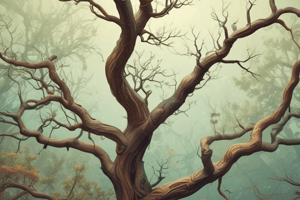Podcast
Questions and Answers
What is the study of chemical processes within living organisms called?
What is the study of chemical processes within living organisms called?
- Biochemistry (correct)
- Ecology
- Microbiology
- Botany
What is the process by which cells communicate with each other?
What is the process by which cells communicate with each other?
- Cell Signaling (correct)
- Mitosis
- Cell Division
- Meiosis
What is the physical characteristic of an organism determined by its genotype?
What is the physical characteristic of an organism determined by its genotype?
- Genotype
- DNA Structure
- Gene Expression
- Phenotype (correct)
What is the process by which the best-adapted individuals in a population survive and reproduce?
What is the process by which the best-adapted individuals in a population survive and reproduce?
What is the community of organisms and their environment called?
What is the community of organisms and their environment called?
What is the study of the interactions between organisms and their environment?
What is the study of the interactions between organisms and their environment?
What is the study of the structure, function, and behavior of cells?
What is the study of the structure, function, and behavior of cells?
What is the study of heredity and variation?
What is the study of heredity and variation?
Flashcards are hidden until you start studying
Study Notes
Branches of Biology
- Botany: study of plants
- Zoology: study of animals
- Microbiology: study of microorganisms
- Ecology: study of interactions between organisms and their environment
- Biochemistry: study of chemical processes within living organisms
- Molecular Biology: study of biological molecules and their interactions
- Genetics: study of heredity and variation
- Evolutionary Biology: study of evolution and diversity of life
- Biophysics: study of physical principles underlying biological processes
Cell Biology
- Cell Structure: cell membrane, cytoplasm, nucleus, mitochondria, ribosomes
- Cell Functions: metabolism, growth, reproduction, response to stimuli
- Cell Division: mitosis, meiosis
- Cell Signaling: communication between cells
Genetics
- Genotype: genetic makeup of an organism
- Phenotype: physical characteristics of an organism
- Mendel's Laws: laws of inheritance
- DNA Structure: double helix, nucleotides (A, C, G, T)
- Gene Expression: transcription, translation
Evolution
- Theory of Evolution: gradual change over time
- Natural Selection: survival and reproduction of fittest individuals
- Species: group of interbreeding organisms
- Fossil Record: evidence of evolution
- Comparative Anatomy: study of similarities and differences between species
Ecology
- Ecosystem: community of organisms and their environment
- Biotic Factors: living components (organisms)
- Abiotic Factors: non-living components (light, temperature, water)
- Food Chain: sequence of energy transfer
- Population Dynamics: growth, decline, and interactions of populations
Branches of Biology
- Botany involves the study of plants
- Zoology is concerned with the study of animals
- Microbiology focuses on microorganisms
- Ecology examines the interactions between organisms and their environment
- Biochemistry delves into the chemical processes within living organisms
- Molecular Biology explores biological molecules and their interactions
- Genetics investigates heredity and variation
- Evolutionary Biology delves into the evolution and diversity of life
- Biophysics studies the physical principles underlying biological processes
Cell Biology
Cell Structure
- The cell membrane separates the cell from its environment
- Cytoplasm is the jelly-like substance inside the cell membrane
- The nucleus contains genetic material
- Mitochondria generate energy for the cell
- Ribosomes are responsible for protein synthesis
Cell Functions
- Metabolism involves energy conversion and nutrient utilization
- Growth and reproduction are essential cell functions
- Cells respond to stimuli from their environment
- Cells maintain homeostasis to survive
Cell Division
- Mitosis is the process of cell division resulting in two identical daughter cells
- Meiosis involves the reduction of chromosomes by half, resulting in four daughter cells
Cell Signaling
- Cell signaling enables communication between cells through chemical signals
- This process is crucial for coordination and integration of cellular activities
Genetics
Genotype and Phenotype
- Genotype refers to the genetic makeup of an organism
- Phenotype describes the physical characteristics of an organism resulting from its genotype
Mendel's Laws
- The Law of Segregation states that each pair of alleles separates during gamete formation
- The Law of Independent Assortment states that alleles separate independently during gamete formation
- The Law of Dominance states that dominant alleles mask recessive alleles
DNA Structure
- DNA is structured as a double helix
- Nucleotides (A, C, G, T) are the building blocks of DNA
Gene Expression
- Transcription involves the synthesis of RNA from DNA
- Translation involves the synthesis of proteins from RNA
Evolution
Theory of Evolution
- Evolution involves the gradual change of species over time
- This change is driven by genetic variation and environmental pressures
Natural Selection
- Natural Selection is the process by which fittest individuals survive and reproduce
- This leads to the accumulation of adaptations over time
Species
- A species is a group of interbreeding organisms
- Species are reproductively isolated from one another
Fossil Record
- The Fossil Record provides evidence of evolution through the preservation of ancestral remains
- Fossils display similarities and differences with modern organisms
Comparative Anatomy
- Comparative Anatomy studies the similarities and differences between species
- This field provides evidence for evolutionary relationships between species
Ecology
Ecosystem
- An ecosystem consists of a community of organisms and their environment
- Ecosystems can be aquatic or terrestrial
Biotic and Abiotic Factors
- Biotic factors include living components such as organisms
- Abiotic factors include non-living components like light, temperature, and water
Food Chain
- A food chain is a sequence of energy transfer from one organism to another
- Energy flows from primary producers to top predators
Population Dynamics
- Population dynamics involve the growth, decline, and interactions of populations
- These interactions can be influenced by biotic and abiotic factors
Studying That Suits You
Use AI to generate personalized quizzes and flashcards to suit your learning preferences.




